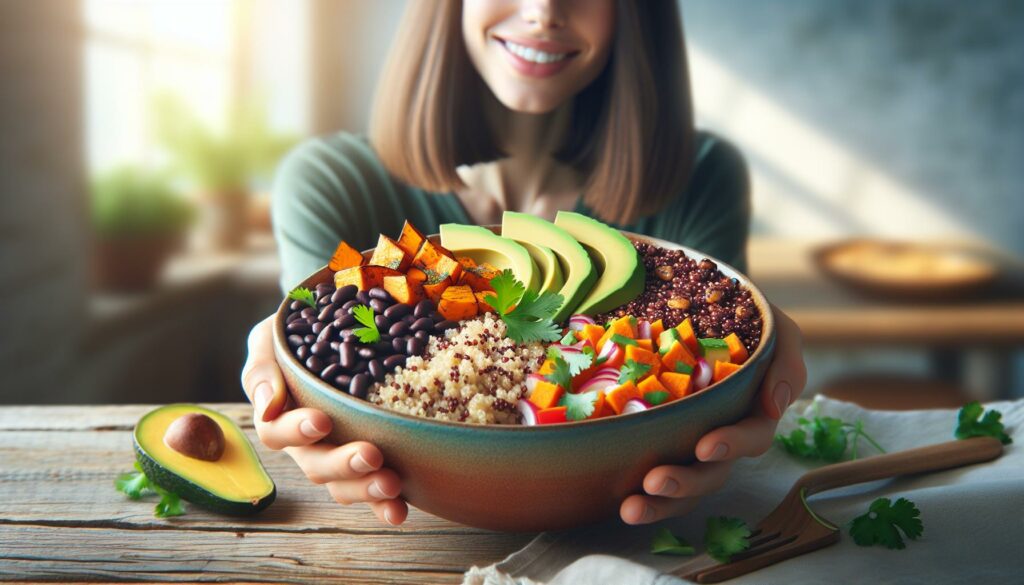Grain bowls have become the rockstars of healthy eating with their perfect blend of nutrition and Instagram-worthy appeal. These customizable bowls pack a powerful punch of whole grains protein and colorful vegetables making them an ideal choice for health-conscious food lovers who don’t want to compromise on taste.
Whether you’re a busy professional looking for meal-prep solutions or simply trying to add more wholesome ingredients to your diet grain bowls are the answer. They’re incredibly versatile and can transform basic pantry staples into exciting meals that’ll make your taste buds dance. From quinoa to farro these nutrient-rich bases serve as the perfect foundation for endless combination possibilities that’ll keep your meals interesting and your body energized.
Healthy Grain Bowl Recipes
The foundation of a perfect grain bowl lies in its balanced composition of nutrients and textures. Creating a wholesome grain bowl involves combining specific elements in the right proportions to achieve optimal flavor and nutritional balance.
Essential Components for Balance
A well-structured grain bowl contains five key components: whole grains (25%), lean proteins (25%), vegetables (30%), healthy fats (10%) and flavorful toppings (10%). The grain base provides complex carbohydrates while proteins like grilled chicken, tofu or chickpeas offer sustained energy. Fresh or roasted vegetables add essential vitamins minerals plus fiber. Healthy fats from avocados nuts or olive oil enhance nutrient absorption. Toppings such as seeds herbs or light dressings contribute texture depth without overwhelming the bowl’s nutritional profile.
| Grain Type | Water Ratio | Cooking Time |
|---|---|---|
| Quinoa | 1:2 | 15-20 min |
| Brown Rice | 1:2.5 | 40-45 min |
| Farro | 1:3 | 25-30 min |
| Amaranth | 1:2.5 | 20-25 min |
Top Healthy Grain Bowl Combinations

Here are three nutrient-packed grain bowl combinations that blend global flavors with wholesome ingredients. Each recipe serves 4 portions with distinct flavor profiles.
Mediterranean Quinoa Bowl
A protein-rich quinoa base creates the foundation for this Mediterranean-inspired bowl. Red bell peppers, cucumber slices, cherry tomatoes, kalamata olives combine with chickpeas to deliver authentic Mediterranean flavors. Fresh spinach leaves add vibrant color while crumbled feta cheese provides tangy notes. A drizzle of olive oil mixed with lemon juice ties the ingredients together. The bowl includes nutrient-dense toppings like toasted pine nuts, chopped parsley along with a sprinkle of za’atar seasoning.
Asian-Inspired Brown Rice Bowl
Brown rice forms the base of this umami-rich bowl paired with edamame beans for plant-based protein. Pan-seared tofu cubes marinated in soy sauce add hearty texture while shredded carrots, sliced red cabbage provide crunch. Steamed broccoli florets enhance the nutritional profile with vitamins K C. A ginger-sesame dressing made from rice vinegar tamari brings authentic Asian flavors. Garnishes include nori strips, green onions sesame seeds furikake seasoning.
Mexican Black Bean and Farro Bowl
Nutty farro grain combines with black beans to create a protein-fiber rich foundation. Roasted sweet potato cubes seasoned with cumin paprika deliver complex carbohydrates. Fresh corn kernels diced red onions bring sweetness crunch while cherry tomatoes add acidity. Sliced avocado provides healthy fats along with pickled jalapeños for heat. Toppings include fresh cilantro lime wedges cotija cheese plus a chipotle-lime crema drizzle.
| Bowl Type | Protein (g) | Fiber (g) | Calories |
|---|---|---|---|
| Mediterranean | 22 | 12 | 425 |
| Asian | 19 | 14 | 390 |
| Mexican | 24 | 16 | 450 |
Meal Prep Tips for Grain Bowls

Efficient meal preparation transforms grain bowls into convenient weekday meals. Strategic planning enables the creation of multiple servings while maintaining freshness throughout the week.
Make-Ahead Components
Batch cooking grains forms the foundation of efficient meal prep. Cook 3-4 cups of different grains (quinoa, farro, brown rice) on Sunday to create varied bases throughout the week. Roast multiple vegetable combinations at 400°F for 25 minutes: sweet potatoes with Brussels sprouts, cauliflower with broccoli or bell peppers with zucchini. Prepare protein options like grilled chicken breasts, baked tofu blocks or seasoned chickpeas in 2-cup portions. Mix signature dressings in 8-ounce mason jars:
- Lemon tahini (keeps 7 days)
- Ginger sesame (keeps 5 days)
- Chipotle lime (keeps 4 days)
Storage Guidelines
Each component requires specific storage methods to maintain quality:
| Component | Container Type | Storage Duration | Temperature |
|---|---|---|---|
| Cooked Grains | Airtight Glass | 4-5 days | 40°F |
| Roasted Vegetables | Glass Container | 3-4 days | 40°F |
| Prepared Proteins | BPA-free Plastic | 3-4 days | 40°F |
| Fresh Greens | Paper Towel Lined | 5-7 days | 40°F |
| Dressings | Mason Jars | 4-7 days | 40°F |
Store cut avocados with lemon juice in an airtight container. Pack fresh herbs in slightly damp paper towels. Keep nuts seeds in sealed containers at room temperature for optimal crunch.
Customizing Your Grain Bowl

Creating personalized grain bowls offers endless opportunities to mix flavors textures based on individual preferences dietary requirements.
Protein Options
Plant-based proteins include tempeh (20g protein per cup) black beans (15g protein per cup) chickpeas (14g protein per cup). Animal proteins incorporate grilled chicken breast (38g protein per cup) wild-caught salmon (34g protein per cup) hard-boiled eggs (6g protein per egg). Marinated tofu adds 10g protein per cup while lending itself to diverse flavor profiles such as sesame ginger teriyaki soy garlic. Protein combinations work effectively together: eggs pair with black beans lentils match with grilled chicken salmon complements chickpeas.
Seasonal Vegetable Combinations
Spring vegetables feature asparagus peas radishes baby greens. Summer produce brings tomatoes bell peppers zucchini corn eggplant. Fall vegetables showcase roasted butternut squash brussels sprouts rainbow carrots. Winter options include roasted root vegetables kale swiss chard cabbage. Color combinations enhance nutritional variety: orange sweet potatoes pair with purple cabbage green broccoli pairs with red bell peppers yellow corn matches with dark leafy greens. Roasting vegetables at 400°F for 20-25 minutes intensifies their natural flavors creates caramelized edges adds depth to grain bowls.
Flavorful Dressings and Sauces
A versatile sauce enhances grain bowls by adding moisture depth flavor. These homemade dressings pair perfectly with the previously mentioned Mediterranean Asian Mexican bowls.
Classic Tahini Dressing
- Blend 1/4 cup tahini with 2 tablespoons lemon juice
- Mix in 1 minced garlic clove 1/4 teaspoon salt
- Add water until reaching desired consistency
- Stores in refrigerator for 5 days
Ginger Sesame Sauce
- Combine 3 tablespoons rice vinegar with 2 tablespoons soy sauce
- Whisk in 1 tablespoon sesame oil 1 teaspoon grated ginger
- Add 1 minced garlic clove 1 teaspoon honey
- Keeps fresh for 7 days when refrigerated
- Purée 1 cup cilantro with 1/4 cup lime juice
- Add 1/3 cup olive oil 1 garlic clove
- Season with salt pepper to taste
- Maintains freshness for 4 days refrigerated
| Dressing Type | Calories per 2 tbsp | Storage Time |
|---|---|---|
| Tahini | 120 | 5 days |
| Ginger Sesame | 85 | 7 days |
| Cilantro Lime | 95 | 4 days |
These dressings contain no artificial preservatives additives. Each sauce recipe yields approximately 3/4 cup serving. Store dressings in airtight glass containers. Bring refrigerated dressings to room temperature before using. Shake well before each use to recombine ingredients.
Nutrition Benefits of Grain Bowls
Grain bowls pack essential nutrients in a single dish through their balanced combination of whole grains, proteins, vegetables, and healthy fats. Each component contributes specific nutritional benefits:
Whole Grains (Base)
- Brown rice delivers manganese for bone health plus B vitamins
- Quinoa contains complete protein with all 9 essential amino acids
- Farro offers 7g of fiber per serving to support digestive health
- Barley provides selenium which boosts immune system function
Protein Sources
- Lean proteins supply 20-25g per serving for muscle maintenance
- Plant proteins contain beneficial phytonutrients and antioxidants
- Fish adds omega-3 fatty acids for heart and brain health
- Legumes combine protein with soluble fiber for steady energy
Vegetable Benefits
- Dark leafy greens provide iron, calcium and vitamin K
- Cruciferous vegetables contain cancer-fighting compounds
- Orange vegetables deliver beta carotene for eye health
- Raw vegetables preserve heat-sensitive vitamins C and B
| Nutrient | Amount per Bowl | % Daily Value |
|---|---|---|
| Protein | 25-30g | 50-60% |
| Fiber | 8-12g | 32-48% |
| Iron | 4-6mg | 22-33% |
| Vitamin A | 4000-6000 IU | 80-120% |
- Avocados contain monounsaturated fats for heart health
- Nuts provide vitamin E and plant sterols
- Seeds add minerals like zinc and magnesium
- Olive oil delivers anti inflammatory compounds
The diverse ingredients create a complete meal that maintains stable blood sugar levels through complex carbohydrates combined with fiber and protein. Regular consumption supports weight management through portion control and nutrient density.
Colorful Vegetables and Flavorful Toppings
Grain bowls stand as a testament to nutritious eating that’s both convenient and delicious. They offer endless possibilities for creating balanced meals while accommodating various dietary preferences and nutritional needs.
With proper planning and preparation these customizable bowls become an easy solution for maintaining a healthy lifestyle. Whether following the Mediterranean Quinoa Bowl Asian-Inspired Brown Rice Bowl or Mexican Black Bean and Farro Bowl recipes anyone can create nourishing meals that satisfy both hunger and wellness goals.
By mastering the art of grain bowl assembly and keeping a well-stocked pantry everyone can enjoy these vibrant nutrient-rich meals throughout the week. The combination of whole grains lean proteins colorful vegetables and flavorful toppings proves that healthy eating doesn’t mean sacrificing taste or satisfaction.

